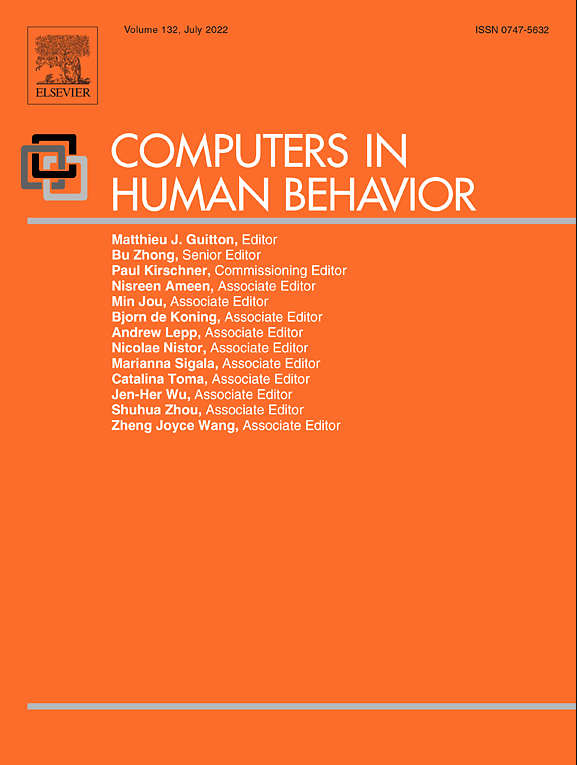Editorial Board / Publication information
Review on teaching and learning of computational thinking through programming: What is next for K-12?
The measurement of Internet addiction: A critical review of existing scales and their psychometric properties
Internet addiction among Chinese adolescents: The effect of parental behavior and self-control
Video games and prosocial behavior: A study of the effects of non-violent, violent and ultra-violent gameplay
“Maybe you don’t want to face it” – College students’ perspectives on cyberbullying
An eye movement analysis of highlighting and graphic organizer study aids for learning from expository text
Glancing up or down: Mood management and selective social comparisons on social networking sites
Promote physical activity among college students: Using media richness and interactivity in web design
Emergent behaviors in computer-based learning environments: Computational signals of catching up
Reading this may harm your computer: The psychology of malware warnings
Comparing the effects of worked examples and modeling examples on learning
Word sense disambiguation using evolutionary algorithms – Application to Arabic language
Examining WeChat users’ motivations, trust, attitudes, and positive word-of-mouth: Evidence from China
Effects of luminance and illuminance on visual fatigue and arousal during digital reading
Effects of visual feedback on medical students’ procrastination within web-based planning and reflection protocols
Association between online harassment and exposure to harmful online content: A cross-national comparison between the United States and Finland
Who am I? Representing the self offline and in different online contexts
The effects of individual differences on e-learning users’ behaviour in developing countries: A structural equation model
With a little help of my peers. The supportive role of online contacts for the unemployed
The sending and receiving of sexually explicit cell phone photos (“Sexting”) while in high school: One college’s students’ retrospective reports
Professional or interactive: CEOs’ image strategies in the microblogging context
The effect of gratifications derived from use of the social networking site Qzone on Chinese adolescents’ positive mood
Competent or clueless? Users’ knowledge and misconceptions about their online privacy management
Everyday deception or a few prolific liars? The prevalence of lies in text messaging
Social network site use, mobile personal talk and social capital among teenagers
What’s going on? Age, distraction, and multitasking during online survey taking
Getting close from far away: Mediators of the association between attachment and blogging behavior
Cyberbullying among high school students in Japan: Development and validation of the Online Disinhibition Scale
Increasing exergame physical activity through self and opponent avatar appearance
How do typically developing children and children with autism perceive different social robots?
Social impacts in social media: An examination of perceived truthfulness and sharing of information
The future of online therapy
Does social capital affect SNS usage? A look at the roles of subjective well-being and social identity
Pathological video game playing in Spanish and British adolescents: Towards the exploration of Internet Gaming Disorder symptomatology
Be careful what you wish for: The impact of advertisement choice on viewers’ expectations
How people do relational reasoning? Role of problem complexity and domain familiarity
Exploring factors related to primary school pupils’ ICT self-efficacy: A multilevel approach
Emotional disclosure on social networking sites: The role of network structure and psychological needs
Measuring cognitive load in practicing arithmetic using educational video games on a shared display
Exposure to sexualized media content and selective attention for sexual cues: An experimental study
Hyperaudio learning for non-linear auditory knowledge acquisition
Mapping virtual communities by their visual productions: The example of the Second Life Steampunk community
From paper to web: Mode equivalence of the ARHQ and NEO-FFI
Online social networking behaviors among Chinese younger and older adolescent: The influences of age, gender, personality, and attachment styles
Introduction to the special issue on designing social media for change
Does offline political segregation affect the filter bubble? An empirical analysis of information diversity for Dutch and Turkish Twitter users
Design challenges in motivating change for sustainable urban mobility
Multilingual use of Twitter: Social networks at the language frontier
BallotShare: An exploration of the design space for digital voting in the workplace
Online social networks for health behaviour change: Designing to increase socialization
Students’ perceptions of creativity in learning Information Technology (IT) in project groups
Graduate students’ creative professional virtual community behaviors and their creativity
Adoption of e-book among college students: The perspective of an integrated TAM
Exploring students learning behavior with an interactive etextbook in computer science courses
Process mining analysis of conceptual modeling behavior of novices – empirical study using JMermaid modeling and experimental logging environment
The benefits and dangers of flow experience in high school students’ internet usage: The role of parental support
The influence of using affective tutoring system in accounting remedial instruction on learning performance and usability
Youth science identity, science learning, and gaming experiences
Learner reflections in virtual vs. blended EAP classes
Understanding collaborative learning activities in an information ecology: A distributed cognition account

